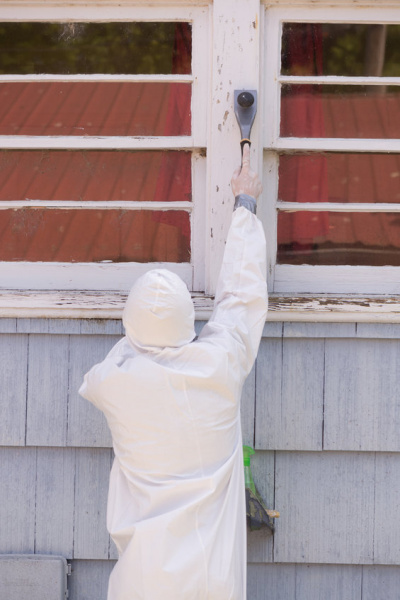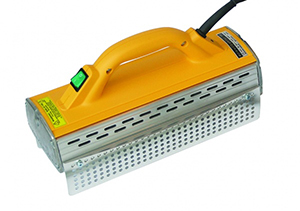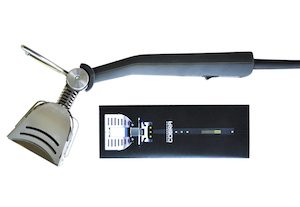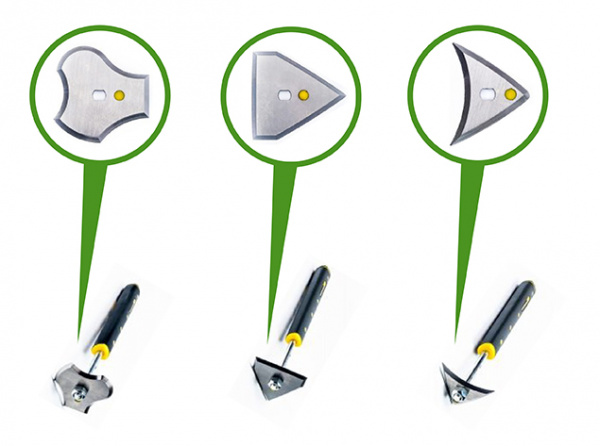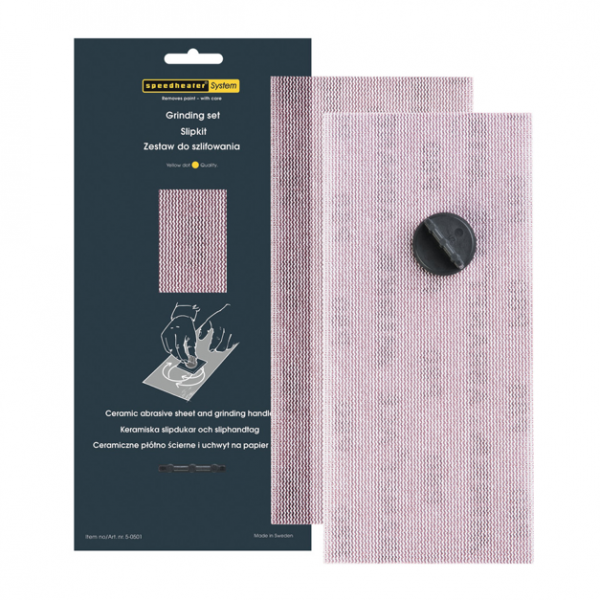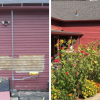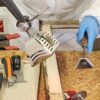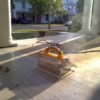Most homeowners and professional painters know that paint removal can be a laborious but often necessary step in home improvement and restoration projects. In addition to giving the new application a nicer appearance, removing previous layers of paint can also protect the surface being repainted and ensure durability and weather resistance. Speedheater™ Infrared Paint Remover technology provides a faster, safer, and cleaner paint removal process while creating high quality results for your repainting projects.
Table of Contents
Why Strip Paint
Planning Your Paint Stripping Project
How to Deal with Lead Paint
Why Use Infrared and Not Heat Guns
Choosing Your Paint Stripper
Choosing Your Paint Scraper
How to Use a Speedheater
How to Use a Pull Paint Scraper
Sharpening Your Scraper Blades
Completing Your Paint Stripping Project
In this article, we will discuss:
- Why it is important to strip your surface before repainting: Stripping old paint and coatings prevents new applications from peeling and cracking.
- How to plan your paint removal project: For best results, outdoor projects should not be done when temperatures are less than 50-60 degrees Fahrenheit.
- Why lead-based paint is dangerous and how Speedheater™ Infrared Paint Removers are the right tools for lead paint removal: Lead-based paint can cause serious damage to your health. Speedheaters™ are designed to safely remove lead paint without emitting dangerous vapors or creating lots of paint dust.
- Why Speedheaters™ are a better option than traditional heat guns: Cheaper heat guns are less efficient and usually create toxic lead fumes.
- Which model of Speedheater™ Infrared Paint Remover is right for your project: Choose between the Speedheater™ 1100 Standard and the Speedheater™ Cobra.
- Which Speedheater™ scraper is right for your project: Eco-Strip offers paint and putty scrapers with blades of different profiles to match your work surface and to outperform other types of scrapers.
- How to position the Speedheater™1100 Standard and Speedheater™ Cobra: Be sure to follow the operating instructions and all safety precautions when using your Speedheater™ Infrared Paint Removers.
- How Do I Use Speedheater™ Pull-Type Scrapers: Most paint scrapers are designed to push dry or soft paint off a surface. Because of their design to pull not push paint for scraping, Speedheater™ scrapers are more efficient than traditional paint scrapers.
- How to Sharpen Your Scraper Blades: Eco-Strip offers The Grinding Kit for quick and easy blade maintenance right at home.
- What Do I Do After I’ve Gotten Most of the Paint Off: Repainting or clear coating with varnish or polyurethane may require different levels of stripping.
Why Strip and Repaint?
While it can be tempting to paint over surfaces with cracked or peeling paint, it is not advisable to do so. Failing paint is usually an indication of issues with surface preparation or with improperly applied previous layers. It all but guarantees that your new application will crack and peel later if you paint right over failed paint.
When painting exterior wood, there should be no more than 15% moisture content in the wood itself; on interior wood, around 12%; and on furniture, about 6%. If paint is applied while the wood is wet, water stays under the paint, the paint then bubbles, and the loose coating will eventually begin to “pop off.” Those openings in the paint surface also will allow more moisture to seep under the paint and into the wood. If you are repainting a wood surface, you will get the best results when you fully remove all the layers of old paint and make sure the surface is completely dry before repainting.
Dirt, dust, mold, and algae on a previously painted surfaces can also cause your new application to fail. The new layers of paint will not properly adhere to such a dirty surface. To clean a dirty surface, it may seem efficient to pressure wash it and then repaint it. However, this can push water into the wood and extend your drying and preparation time. A more gentle method is to use a non-toxic, environmentally-friendly cleaner such as Simple Green and manually scrub the surfaces. With either method, you must let the wood dry out before applying your new application.
In addition to moisture and surface dirt issues, there can be paint adherence and durability problems when switching from old lead-based paint to modern acrylic, latex, or even oil-based paint. Stripping all the previous coatings remains the best option. The Speedheater™ Method kills mold and algae spores while it safely heats the paint for clean, fast, and efficient removal.
How Do I Decide When to Use the Speedheater™ Infrared Paint Remover to Strip Paint and Window Glazing Putty?
Properly planning your paint removal project is the first step in getting good results from your new paint application. Before starting your paint removal, consider the seasons and current weather. If you are working on an outdoor project, it is important to work when the wood and air are warm.
To achieve the best results, exterior paint stripping should be done when the outdoor temperatures are greater than 50-60 degrees Fahrenheit. In lower temperatures or windy conditions, the heated paint begins to cool and harden before it can be properly scraped. This often leads to uneven paint removal and later issues for application of the new paint.
Ideally, paint removal should be done in moderate to warm temperatures under dry conditions. When outdoors, the application of new paint should be done immediately after removing the old layers. Leaving the bare surface exposed allows it to possibly absorb outside moisture before it is repainted. Indoor projects usually are not at risk of moisture issues but it is be best to work on them in a heated space during the winter.
Why Is Lead-Based Paint So Dangerous?
Since colonial times in the United States, lead was a common additive in paint. It was used to accelerate drying, add moisture resistance, and extend paint durability. Medical and scientific research show that even small exposures to lead over time can cause lead poisoning and permanent damage to humans and animals. In 1978, the U.S. banned the use of lead-based paints because of the potential health hazards.
Most often, lead poisoning in the US is caused by inhaling dust or fumes from lead-based paint removal or from the creation of lead dust at friction points such as doors and windows. Ingested lead paint chips can also cause lead poisoning but usually are large enough not to be absorbed but rather are excreted. Infants and toddlers crawl on floors where lead dust gathers, and they put foreign objects dirty with lead dust in their mouths. Thus, they are the most likely to get lead poisoned in the home. Their developing bodies absorb and retain more lead than adults making them even more vulnerable.
Lead fumes and dust are absorbed through the lungs and stomach into the blood and ends up accumulating in bones. Small exposures over years can build up and cause lead poisoning later. The fetus of a pregnant women is also at great risk if the mother is exposed to lead paint dust or fumes at any point before or during the pregnancy. The fetus draws calcium from the mother’s bones and with it can come the lead. Then, the fetus can become poisoned from its pregnant mother.
Anyone exposed to lead is at risk of poisoning. The issue is how much exposure. Lead exposure to young children can cause permanent, irreversible nervous system and brain damage, cognitive impairments, serious behavioral issues, and other organ damage to their fast developing bodies. Workers doing old paint removal in their jobs or homeowners stripping their own houses are also highly susceptible to lead poisoning. In adults, nervous system, brain and other organ damage as well as sexual dysfunction can result from lead poisoning.
The older a US home or commercial building is built prior to 1978, the greater the likelihood that lead paint is present. In fact, 87% of US homes built before 1940 are likely to have lead paint; 69% of buildings between 1941-1960; and 24% of buildings between 1961-1978. If you notice cracked and peeling paint or plan on stripping paint in an older home, it is important to determine if the paint contains lead. You can purchase an inexpensive home test kit called LeadCheck at most hardware and paint retailers. This swab test will give you results immediately. More extensive but more expensive lead testing can help pinpoint where in the building is the highest lead level and help you prioritize paint stripping projects. If paint in any part of the building tests positive for lead, it should be assumed that all the paint has lead in it, and lead safe work practices should be used.
If your home does contain lead-based paint, the Speedheater™ Method is the safest option to remove the paint, minimize exposure and protect your family. Speedheater™ Infrared technology uses infrared rays to warm the paint to a temperature between 400-600 degrees Fahrenheit. Lead turns to toxic fumes at around 1000 degrees Fahrenheit. Speedheaters™ when used properly do not heat paint to this level and are not creating lead fumes.
When working with lead-based paints, it is important to take all necessary safety precautions. Lead safe work practices include always wearing an organic vapor mask or respirator, gloves, eye protection and a full body Tyvek suit for disposal or clothing which will be washed separately after paint stripping. Find more tips here on how to keep your family safe from lead poisoning.
Why Use Speedheater™ Infrared Paint Removers Instead of Cheaper Heat Guns for Paint Stripping?
There are heat guns at various price points that are often used for paint stripping. A traditional heat gun works much like a hairdryer blowing very hot air. The heat gun method of paint removal needs to heat paint on a surface to over 1000 degrees Fahrenheit to make the paint release for scraping. Because lead-based paints begin to vaporize at 900 – 1000 degrees Fahrenheit, the risk of the lead paint emitting toxic lead fumes is high using heat guns.
In addition, the hot, blowing air from heat guns must be moved back and forth across a painted area to prevent the paint from igniting and the wood from scorching. The heat and where it goes are much harder to control. When restoring glass windows, both the paint and glazing putty holding the glass in place usually need to be removed. Glass breaks where different temperatures meet. The uneven heat created from the heat gun’s blowing hot air near this glass makes the risk of breaking the glass much higher.
Speedheater™ Infrared Paint Removers, on the other hand, do not use blowing hot air. They emit infrared rays which penetrate through the paint or window putty and into the wood beneath it. The infrared rays at a very specific wavelength move the molecules in the wood, create friction and then heat. This heat goes up from the wood and into the bottom layer of paint releasing it from the wood at a lower temperature – 400 to 600 degrees Fahrenheit. It is very unlikely that lead fumes are generated when the paint is heated to these lower temperatures. Also, infrared rays heat only where they are pointed. This allows for more even temperatures across a controlled area. The evenly-distributed heat created by the Speedheaters™ greatly reduces the risk of breaking adjacent glass in windows.
Some other benefits of Speedheaters™ include:
- Energy efficiency – Speedheaters™ operate at lower temperatures than traditional heat guns and use less energy to maintain those temperatures.
- No noise while in use – Speedheaters™ are completely silent during use; traditional heat guns emit a loud sound like a blowing hair dryer; and electric sanders also make loud noises.
- Simultaneous heating and scraping – The design of the Speedheaters™ make it easy to move the heater to the next section while scraping the already heated section.
- Easy clean up – The Speedheater™ Method of heating and scraping soft paint creates little dust or chips. Instead, paint comes off in long ribbons or clumps which are easier to contain and dispose of than paint dust and chips.
- No additional surface preparation needed – The Speedheater™ Method leaves stripped surfaces with bare, dry wood which is ready to paint immediately with no additional sanding or prep needed.
How Do I Decide Which Model of Speedheater™ Infrared Paint Remover Is Best for My Project?
Once you’ve decided to use Speedheater™ infrared technology for your paint removal project, the next step is to select the model best suited to your needs – the Speedheater™ 1100 Standard Kit or the Speedheater™ Cobra.
The Speedheater™ 1100 is a great option for projects with large surface areas, such as wood exterior siding, floors, baseboards, trimwork and other mostly-flat surfaces. It can heat a 3”x10” area at one time, and it allows for quick and thorough scraping with long strokes. Speedheaters™ work best with oil-based and latex paints, varnish, or polyurethane coatings. It can also be used to remove thickly-coated paint on sheet metal and plaster.
The Speedheater™ Cobra is a better option for smaller areas, tight spaces, and irregular surfaces. The Cobra’s infrared rays are concentrated to a 3”x3” area. It takes 3-5 seconds or less to release the hot paint from the wood. The Cobra is often the tool of choice for window restoration because the direct infrared rays can reach into tight corners and edges to remove both paint and window glazing putty without damaging the glass. The Speedheater™ Cobra is also a popular tool for furniture refinishing, as it gently removes varnish and paint from lathe work, spindles and detailed and carved surfaces. The infrared heat can soften glue or epoxy sufficiently to allow a wood joint to be pulled apart without damaging the wood.
How Do I Decide Which Scrapers Are Best for My Project?
Traditional, thin metal paint scrapers like putty or drywall knives are inexpensive and readily available at any hardware, paint or home improvement store. Despite these benefits, they may not always be the best choice for your paint removal project. These hand-held scrapers work when you push the paint away. This method can become very tiresome, cause muscle fatigue, and extend the time it takes to complete the paint stripping.
Using Eco-Strip’s Speedheater™ scrapers is much less physically demanding. They are designed to be pulled toward the operator and to work with less effort. The long, ergonomic handles allow for a two-handed grip which provides a more even pressure across a wider surface. This means fewer strokes are needed to clean a larger area and muscle fatigue is less.
The blades on Speedheater™ scrapers are made from thicker, spring steel which resists chipping, bending, and snapping. The very sharp, beveled edges of the blades quickly and thoroughly remove paint in fewer strokes than thinner blades. Duller blades need more pressure and the nicks and bends in the metal can gouge and damage a wood surface.
The Speedheater™ scraper blades come in different profiles. This variety allows you to match the blade to the work surface for more efficient and effective scraping: the straight-edged Clapboard and 8-Cut scrapers for straight surfaces; and the Boomerang, Profile, and Flexi-Scrapers with convex and concave curve edges for carved, rounded, and wide or narrow grooves.
How Do I Position the Speedheater™ on Surfaces?
When you are ready to use your Speedheater™1100, start by making sure your work area is clean and free of any flammable materials. Once connected to a power source, switch the tool to the ON position, rest it on its handle on a level surface with the heating elements facing up towards open air, and let it preheat. When the infrared bulbs glow bright orange, the tool is ready to use. This should take about two minutes.
Speedheater™1100 on the ground or work table on its handle with the heating elements facing up into the open air. If you leave the work area even for a short break, it is safest to turn the Speedheater™ completely OFF.
When using the Speedheater™ Cobra, all the above safety precautions apply. Once the heating elements are glowing orange, grip with your thumb and forefingers the handle at the underside of the bend. The ergonomic design, the light 22 oz. weight of the Cobra, and the holding of the handle in this way provide good balance of the tool and less wrist and arm fatigue. The angle of the Cobra head safely can be adjusted using its metal support bar which does not get hot. Position the heated bulbs at least an inch above the painted surface (and not directly on it). Hold the unit in this position for 1-5 seconds until the paint begins to smoke and bubble. Move the heating tool 3-5 inches away from the soft paint and at an angle to keep the paint warm during scraping. Then move the Cobra to the next area and heat and scrape until you’ve stripped the entire surface. If the Cobra is not in constant use heating, turn it upside on the metal support bar, again facing the open air. Be careful not to have other objects within 2-3 feet of the emitting heat. If you take a break, as with the Speedheater™1100, turn it off.
How Do I Use Speedheater™ Pull-Type Scrapers?
The purpose of choosing the correct profile for a blade is to reduce the number of strokes needed to clear the surface. Long, flat surfaces are best stripped with the straight-edges blades on the Clapboard and 8-Cut Scrapers. Curved or uneven surfaces may call for the concave or convex-edged blades of the Boomerang, Profile, or Flexi-Scrapers.
Once you’ve selected the scraper with the proper blade, place both hands on the rear of the scraper handle. Position the handle parallel to the work surface. Cut the blade into the soft paint down to the wood, apply an even pressure and pull the scraper and paint towards you. Too strong pressure will gouge the wood; too little pressure will mean you must re-scrape. You should be able to remove all the layers of paint with a few strokes.
What If My Scraper Blades Get Dull?
Over time, Speedheater™ scraper blades may dull with lots of use. The blades can be safely and easily sharpened at home with the Speedheater™ Grinding Kit. The kit’s durable and reusable ceramic grinding cloths and blade holder are portable and easy to use at any work site.
To sharpen your blade, place the Grinding Kit blade holder into the hole in the top side of the blade. The bottom edge of the blade should face down. While firmly grasping the blade holder with your thumb and fingers, press the blade down onto the abrasive paper with a steady pressure. Move it in circles around the cloth. Continue circling the blade for 10-20 seconds until the edge is sharp enough to cut paper. The circular motion, rather than a back and forth motion, sharpens all the blade’s different and beveled edges evenly. If you are using these scrapers extensively and on harder surfaces, you may need to take them to a professional who sharpens blades such as on lawn mowers. Or with practice, you can use a wet grinding wheel if you are careful not to melt the thin, beveled edge. These beveled edged blades and long, ergonomic handles are what make Eco-Strip’s Speedheater™ scrapers the superior choice over traditional hardware store paint scraping tools.
What Do I Do After I’ve Gotten Most of the Paint Off?
Completely removing all the paint or coating down to bare wood may not be necessary if the remaining shadows of paint are smooth and will be covered with paint. If you want a wood surface to be totally bare for staining or clear-coating with varnish or polyurethane, you may need to do a wet sanding only on the areas where the paint has not completely lifted from the surface. Wet sanding prevents the creation of dust. If you’ve done a wet sanding and paint is still lingering, brush on a light coat of linseed oil (either boiled or raw), let it soak into the wood at least overnight. Then repeat the paint removal steps with the Speedheater™ heating the paint for much less time.If the stripped surface is dry, cool, and smooth to the touch, you are ready to begin recoating. Next simply use your preferred paint or other coating and recoat the surface. Step back, look at the beautiful new paint job you did, and be proud. The quality results you see were worth the long hours of labor you dedicated to your home.
The Speedheater™ Infrared technology helps you complete your paint removal project with optimal efficiency. With Eco-Strip’s Speedheater™Method and tools, you’ll have everything you need to complete your paint removal projects and end up with unmatched quality and professional results.
Purchase your Speedheater™ today.




